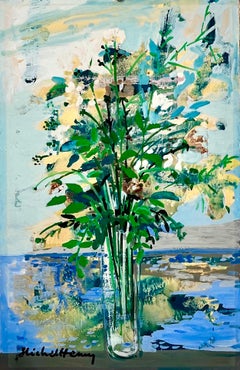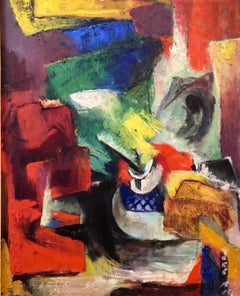Beulah Stevenson Art
to
1
Overall Width
to
Overall Height
to
1
1
1
1
1
1
2
10,138
2,779
1,375
1,369
1
Artist: Beulah Stevenson
Beulah Stevenson, Three Small Sunflowers and Two Roses by the Window
By Beulah Stevenson
Located in New York, NY
This Three Small Sunflowers still-life by Beulah Stevenson (1890-1965) is a joyful modernist composition. With just touches of color she indicates a window and colorful curtains blow...
Category
Mid-20th Century Modern Beulah Stevenson Art
Materials
Watercolor
Related Items
The Terrace
By Maurice Savin
Located in London, GB
'The Terrace', watercolour on art paper, by Maurice Savin (circa 1950s). An inviting scene from the South of France depicts a quiet sun terrace on a balmy day with azure skies. The v...
Category
1950s Modern Beulah Stevenson Art
Materials
Paper, Watercolor
Small, Charming, Fauvist Painting Michel Henry French Modernist School of Paris
By Michel Henry
Located in Surfside, FL
Michel-Henry was born in Langres in 1928 and has shown strong passion for drawing since his childhood. Michel-Henry is acknowledged as an important painter in French contemporary a...
Category
1960s Modern Beulah Stevenson Art
Materials
Paper, Gouache
Original 70's Hand Painted Textile Design Gouache Navy Blue Color on White Paper
Located in ALCOY/ALCOI, ES
Compass Rose and Flower design. Sealed on the back with the design studio name and number 397
We offer a small number of these original illustration designs by this design studio ba...
Category
1970s Modern Beulah Stevenson Art
Materials
Paper, Gouache
$1,017
H 34.65 in W 18.9 in D 0.12 in
A Stunning ca. 1950s Cubist Watercolor of Irises by Rita Duis (Astley-Bell)
Located in Chicago, IL
A stunning Modern Cubist watercolor on paper of purple irises by Chicago and New York artist Rita Duis (Astley-Bell). Signed and inscribed "Duis A.W.S." (American Watercolor Society...
Category
1950s American Modern Beulah Stevenson Art
Materials
Watercolor, Paper
$576 Sale Price
52% Off
H 30 in W 24 in D 0.13 in
Kutschen (carriages); Group of four designs for hansom cabs.
By Alfred Juergens
Located in Middletown, NY
Four pencil drawings, each with hand coloring in watercolor, each 6 3/4 x 10 inches (sheet) (172 x 254 mm), full margins. Each with inscriptions and notations by the artist in the up...
Category
Mid-20th Century American Modern Beulah Stevenson Art
Materials
Handmade Paper, Watercolor, Pencil
$800
H 6.78 in W 10.01 in
'Fruit Still Life' original watercolor and gouache on board, signed Yolanda
Located in Milwaukee, WI
Though signed "Yolanda," the artist of this gouache and watercolor painting is unknown. The still life, contained and symmetrical, is dominated by the form of a pear. On either side,...
Category
Early 20th Century American Modern Beulah Stevenson Art
Materials
Watercolor, Gouache, Board
$875
H 22.5 in W 18.25 in
"500 Calories al mode" The Perfect Meal - Menu - Dessert - Collograph Watercolor
Located in Soquel, CA
"500 Calories al mode" The Perfect Meal - Menu - Dessert - Collograph Watercolor
The artwork "500 Calories al mode" by Betty Swift, created one of a group show at San Francisco Stat...
Category
1980s American Modern Beulah Stevenson Art
Materials
Watercolor, Laid Paper, Etching
$750
H 14 in W 11 in D 0.5 in
Pawel Kontny “New Mexico” 20th-Century Southwestern Modernist Watercolor
By Pawel Kontny
Located in Denver, CO
This 20th-century watercolor painting, “New Mexico,” by Polish-American artist Pawel Kontny, captures the enduring architecture and serene spirit of the American Southwest. The work ...
Category
Mid-20th Century American Modern Beulah Stevenson Art
Materials
Watercolor
$2,200
H 16.25 in W 21.5 in
Hyacinth watercolor by Jessie Bone Charman
Located in Hudson, NY
American artist Jessie Bone Charman (1895-1986) was known for her expressive still-life paintings, landscapes and marine scenes, as well as her abstract watercolors.
The framed dim...
Category
1930s Modern Beulah Stevenson Art
Materials
Paper, Watercolor, Pencil
Back Porch - Santa Cruz California Landscape in Watercolor on Paper
Located in Soquel, CA
Back Porch - Santa Cruz California Landscape in Watercolor on Paper
Detailed still life and landscape by Harry Federico (American, 1922-2022). Several potted plants sit on a porch with a white wrought...
Category
21st Century and Contemporary Modern Beulah Stevenson Art
Materials
Watercolor, Laid Paper
$850
H 19.25 in W 22.25 in D 0.75 in
Still Life with Knife
Located in San Francisco, CA
This artwork "Still Life with Knife" c.1980 is a watercolor on heavy watercolor paper by California artist Charlotte Huntley. It is signed at the low...
Category
Late 20th Century American Modern Beulah Stevenson Art
Materials
Watercolor
Original 70's Hand Painted Textile Design Gouache Pink & Black Color on Paper
Located in ALCOY/ALCOI, ES
Flowers and pixel design. Sealed on the back with design studio name and number 268
We offer a small number of these original illustration designs by this design studio based in Alc...
Category
1970s Modern Beulah Stevenson Art
Materials
Paper, Gouache
$1,017
H 34.65 in W 18.9 in D 0.12 in
Previously Available Items
Beulah Stevenson 1950s Abstract Expressionism American Woman Artist Oil Painting
By Beulah Stevenson
Located in Surfside, FL
Dimensions: 32"h, 25"w canvas; 38.5"h, 32"with frame
Work is titled "Two Lillies"
Elsie Stevenson (1890–1965) was an American painter and printmaker.
Beulah Stevenson, (1875-1965) American painter and printmaker. Born in Brooklyn Heights, Beulah (Elsie Sloan) Stevenson lived there her entire life. In New York she studied at the Pratt Institute and the Art Students League, where her instructors included Ashcan artist John Sloan; in Provincetown, she worked and studied with Abstract Expressionist artist Hans Hofmann (an influential teacher whose students included many notable artists including Lee Krasner, Helen Frankenthaler, Irene Rice Pereira, Gerome Kamrowski, Fritz Bultman, Wolf Kahn, Marisol Escobar and Beulah Stevenson), a long-time curator at the Brooklyn Museum, was also among his pupils. Her work appeared in many group shows, and she won a number of awards. She was a curator at the Brooklyn Museum for many years, and that museum owns a number of examples of her work, as do the Library of Congress and the New York Public Library. Stevenson maintained many professional associations during her career; she was president of the New York Society of Women Artists, a board member of the National Association of Women Artists, and a vice-president of the Brooklyn Society of Artists, Art Institute of Chicago, International Graphic Society Inc., Philadelphia Print Club, Provincetown Art Association and the Creative Artist's Association. She also belonged to the American Artists' Congress which promoted social-realist style of American scene painting, she left to join the Federation of Modern Painters and Sculptors established To Promote Avant-Garde Art. Stevenson was said by a friend to have destroyed many of her papers prior to her death, but a collection was donated to the Archives of American Art at the Smithsonian Institution.
Select Group Exhibitions
Art Institute of Chicago; , Library of Congress, Washington, D.C.; Print Club of Philadelphia; National Arts Club, New York; Metropolitan Museum; Whitney Museum; Brooklyn Museum; Chicago Art Institute; Pennsylvania Academy Of Fine Arts; Rochester Memorial Museum; St. Paul Museum; M. H. De Young Memorial Museum Of Art; Houston Museum Of Art; William R. Nelson Museum Of Art; Columbus Museum Of Art; American Institute Of Graphic Arts; Provincetown Art Association; Columbia Museum Of Art; Schenectady Museum Of Fine Art; Portland Museum, ME; Royal Society, London; Gallery O...
Category
Mid-20th Century Abstract Expressionist Beulah Stevenson Art
Materials
Canvas, Oil
Beulah Stevenson art for sale on 1stDibs.
Find a wide variety of authentic Beulah Stevenson art available for sale on 1stDibs. You can also browse by medium to find art by Beulah Stevenson in paint, canvas, fabric and more. Much of the original work by this artist or collective was created during the 20th century and is mostly associated with the modern style. Not every interior allows for large Beulah Stevenson art, so small editions measuring 15 inches across are available. Customers who are interested in this artist might also find the work of John von Wicht, Sylvia Rutkoff, and Anya Spielman. Beulah Stevenson art prices can differ depending upon medium, time period and other attributes. On 1stDibs, the price for these items starts at $1,500 and tops out at $12,000, while the average work can sell for $6,750.



